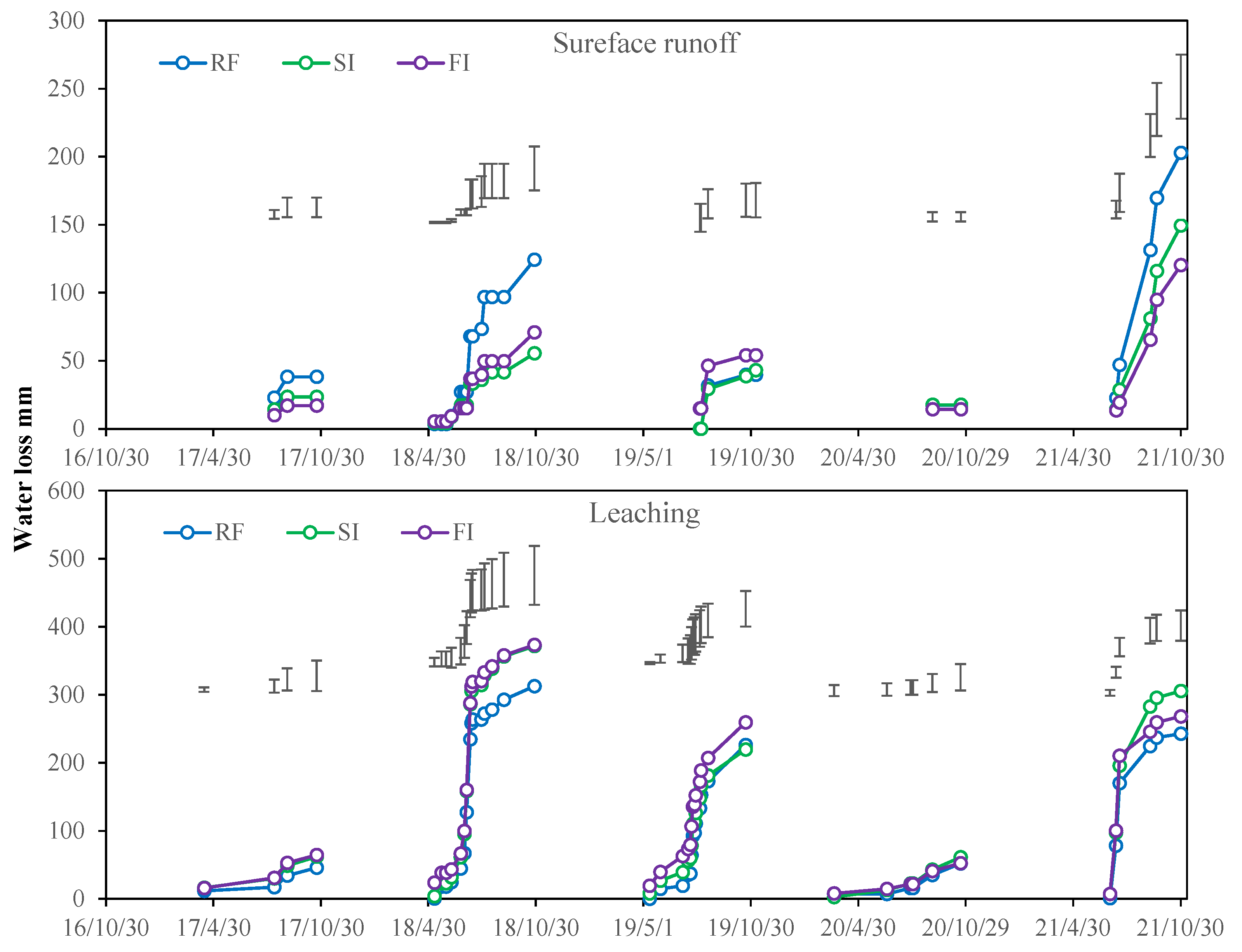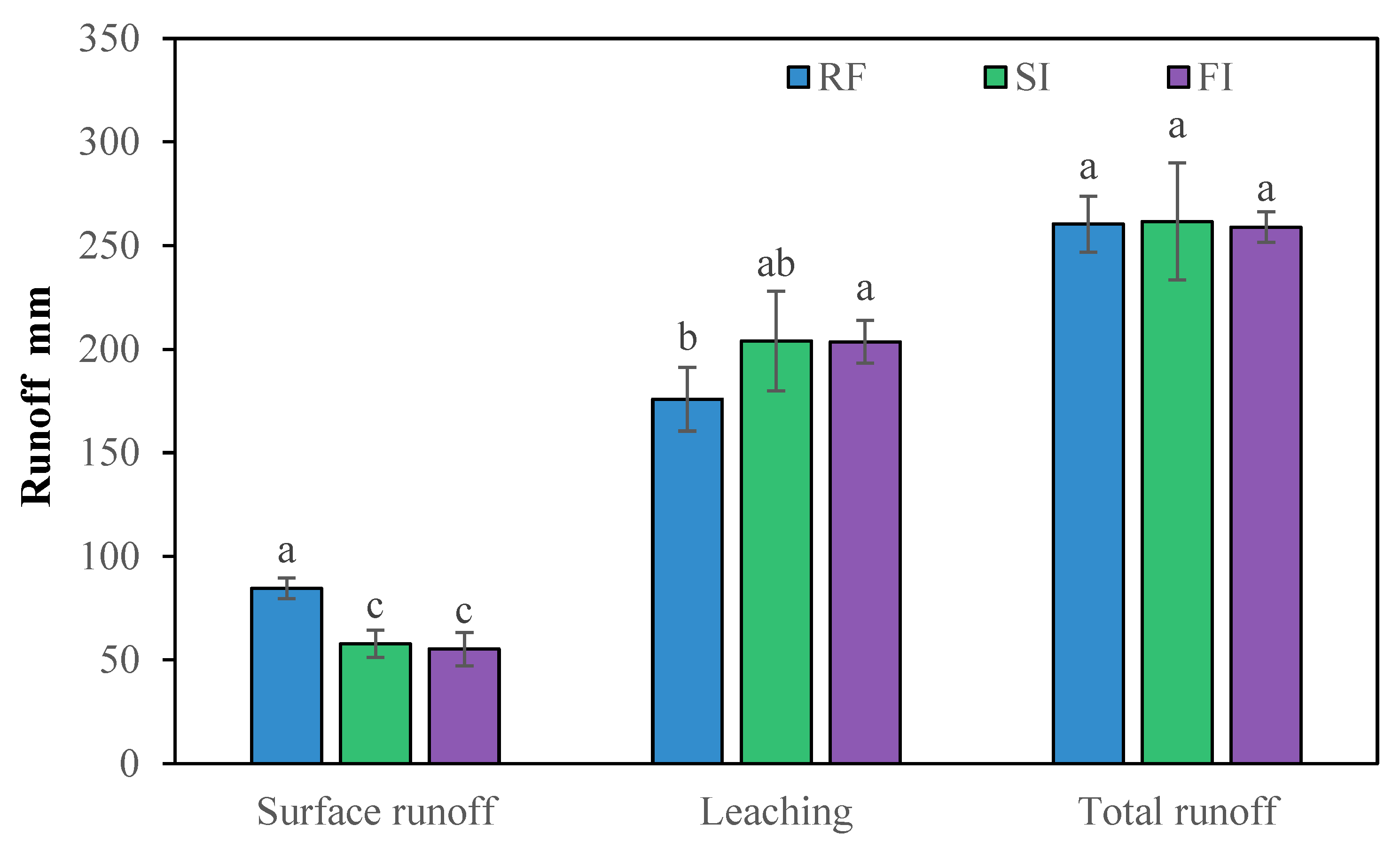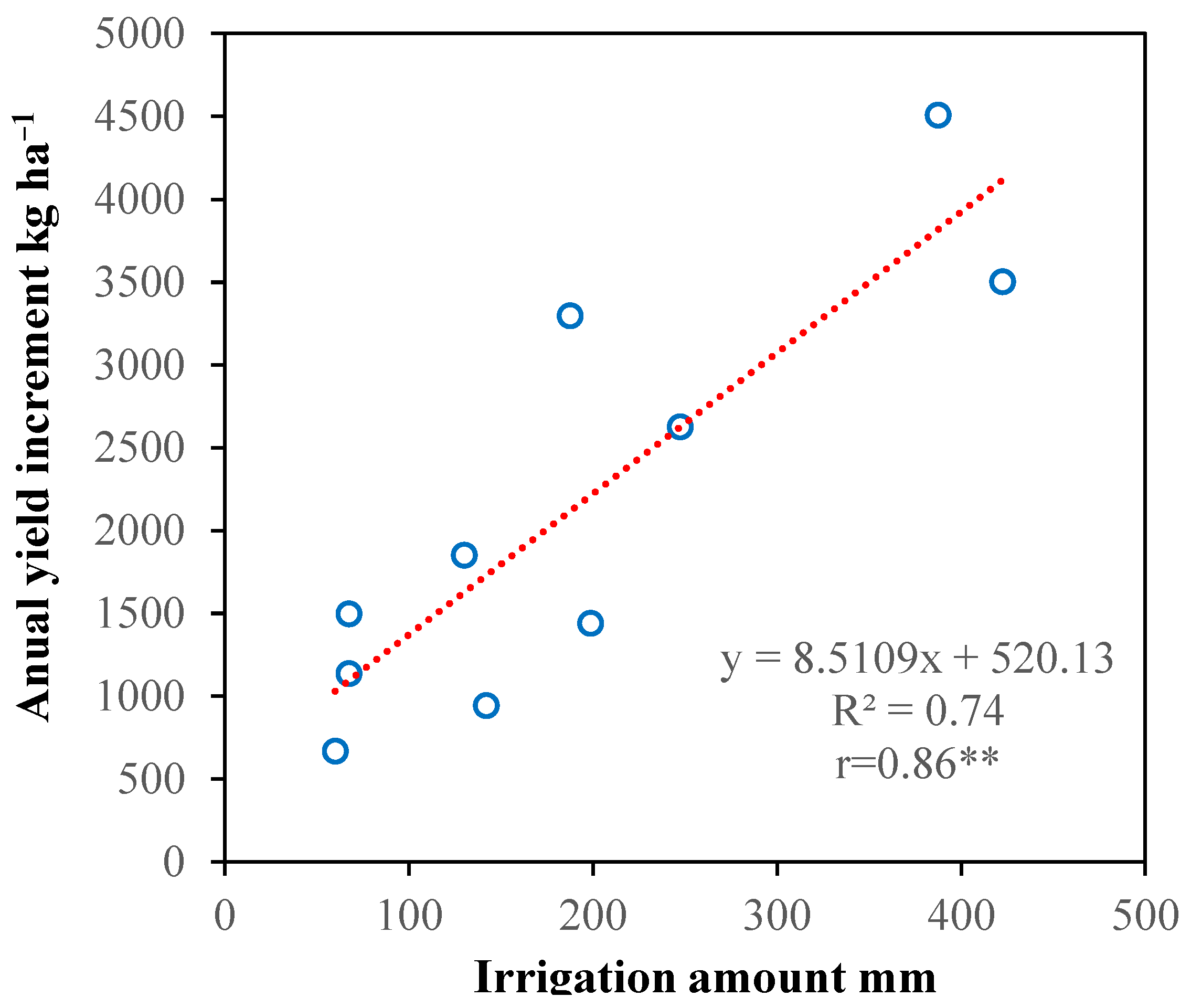Effect of Irrigation on Crop Yield and Nitrogen Loss in Simulated Sloping Land with Shallow Soils
Abstract
1. Introduction
2. Results
2.1. Precipitation
2.2. Yield
2.3. Runoff
2.4. Nitrogen Loss
3. Discussion
3.1. Effect of Irrigation on Crop Yield
3.2. Effect of Irrigation on Runoff
3.3. Effect of Irrigation on Nitrogen Loss
4. Materials and Methods
4.1. Experimental Site
4.2. Experimental Facilities and Design
4.3. Field Management
4.4. Sampling and Measurement
4.5. Statistical Analysis
5. Conclusions
Author Contributions
Funding
Data Availability Statement
Conflicts of Interest
References
- Tilman, D.; Balzer, C.; Hill, J.; Befort, B.L. Global food demand and the sustainable intensification of agriculture. Proc. Natl. Acad. Sci. USA 2011, 108, 20260–20264. [Google Scholar] [CrossRef]
- Bentham, J.; Singh, G.M.; Danaei, G.; Green, R.; Lin, J.K.; Stevens, G.A.; Farzadfar, F.; Bennett, J.E.; Di Cesare, M.; Dangour, A.D. Multidimensional characterization of global food supply from 1961 to 2013. Nat. Food 2020, 1, 70–75. [Google Scholar] [CrossRef]
- Lal, R. Managing world soils for food security and environmental quality. Adv. Agron. 2001, 74, 155–192. [Google Scholar]
- Zhang, J.; He, C.; Chen, L.; Cao, S. Improving food security in China by taking advantage of marginal and degraded lands. J. Clean. Prod. 2018, 171, 1020–1030. [Google Scholar] [CrossRef]
- Fu, Z.; Li, Z.; Cai, C.; Shi, Z.; Xu, Q.; Wang, X. Soil thickness effect on hydrological and erosion characteristics under sloping lands: A hydropedological perspective. Geoderma 2011, 167, 41–53. [Google Scholar] [CrossRef]
- Xiao, Q.; Dong, Z.; Han, Y.; Hu, L.; Hu, D.; Zhu, B. Impact of soil thickness on productivity and nitrate leaching from sloping cropland in the upper Yangtze River Basin. Agric. Ecosyst. Environ. 2021, 311, 107266. [Google Scholar] [CrossRef]
- Montgomery, D.R. Soil erosion and agricultural sustainability. Proc. Natl. Acad. Sci. USA 2007, 104, 13268–13272. [Google Scholar] [CrossRef]
- Hua, L.; Liu, J.; Zhai, L.; Xi, B.; Zhang, F.; Wang, H.; Liu, H.; Chen, A.; Fu, B. Risks of phosphorus runoff losses from five Chinese paddy soils under conventional management practices. Agric. Ecosyst. Environ. 2017, 245, 112–123. [Google Scholar] [CrossRef]
- Zhang, S.; Zhang, G.; Wang, D.; Liu, Q. Abiotic and biotic effects of long-term straw retention on reactive nitrogen runoff losses in a rice–wheat cropping system in the Yangtze Delta region. Agric. Ecosyst. Environ. 2021, 305, 107162. [Google Scholar] [CrossRef]
- Sun, Y.; Chen, S.; Feng, P.; Chen, Q.; Hu, K. Assessing the Fates of Water and Nitrogen on an Open-Field Intensive Vegetable System under. Plants 2024, 13, 2150. [Google Scholar] [CrossRef]
- De Notaris, C.; Rasmussen, J.; Sorensen, P.; Olesen, J. Nitrogen leaching: A crop rotation perspective on the effect of N surplus, field management and use of catch crops. Agric. Ecosyst. Environ. 2018, 255, 1–11. [Google Scholar] [CrossRef]
- Lu, J.; Bai, Z.; Velthof, G.L.; Wu, Z.; Chadwick, D.; Ma, L. Accumulation and leaching of nitrate in soils in wheat-maize production in China. Agric. Water Manag. 2019, 212, 407–415. [Google Scholar] [CrossRef]
- He, J.; Wang, Y.; Li, H.; Ma, J.; Yue, X.; Liang, X.; Hong, Y.; Wang, F.; Hu, C.; Liu, R. Residual Nitrogen and Leaching Losses in the Yellow River Irrigation Area. Plants 2025, 14, 408. [Google Scholar] [CrossRef]
- Bouraima, A.-K.; He, B.; Tian, T. Runoff, nitrogen (N) and phosphorus (P) losses from purple slope cropland soil under rating fertilization in Three Gorges Region. Environ. Sci. Pollut. Res. 2016, 23, 4541–4550. [Google Scholar] [CrossRef] [PubMed]
- Bah, H.; Zhou, M.; Ren, X.; Hu, L.; Dong, Z.; Zhu, B. Effects of organic amendment applications on nitrogen and phosphorus losses from sloping cropland in the upper Yangtze River. Agric. Ecosyst. Environ. 2020, 302, 107086. [Google Scholar] [CrossRef]
- Ariyo, S.O.; Adeyemi, A.A.; Adewale, A.S.; Alao, O.J.; Aderemi, O.V.O.; Sadiat, A.A.; Esther, O.T. Interactive Effects of Nitrogen Fertilization and Harvest Age on the Nutritional Composition of Brachiaria ruziziensis. J. Soil Plant Environ. 2025, 4, 1–17. [Google Scholar] [CrossRef]
- Baig, M.B.; Shahid, S.A.; Straquadine, G.S. Making rainfed agriculture sustainable through environmental friendly technologies in Pakistan: A review. Int. Soil Water Conserv. Res. 2013, 1, 36–52. [Google Scholar] [CrossRef]
- Barros, R.; Isidoro, D.; Aragüés, R. Irrigation management, nitrogen fertilization and nitrogen losses in the return flows of La Violada irrigation district (Spain). Agric. Ecosyst. Environ. 2012, 155, 161–171. [Google Scholar] [CrossRef]
- Zhang, J.; Chen, H.; Fu, Z.; Luo, Z.; Wang, F.; Wang, K. Effect of soil thickness on rainfall infiltration and runoff generation from karst hillslopes during rainstorms. Eur. J. Soil Sci. 2022, 73, e13288. [Google Scholar] [CrossRef]
- Lu, J.; Geng, C.; Cui, X.; Li, M.; Chen, S.; Hu, T. Response of drip fertigated wheat-maize rotation system on grain yield, water productivity and economic benefits using different water and nitrogen amounts. Agric. Water Manag. 2021, 258, 107220. [Google Scholar] [CrossRef]
- Ilham, K.; Aziz, B.; Oussama, H.; Ali, A. Integrated Management of Water, Nitrogen, and Genotype Selection for Enhanced Wheat Productivity in Moroccan Arid and Semi-Arid Regions. Agronomy 2025, 15, 612. [Google Scholar] [CrossRef]
- Song, Z.; Peng, Y.; Li, Z.; Zhang, S.; Liu, X.; Tan, S. Two irrigation events can achieve relatively high, stable corn yield and water productivity in aeolian sandy soil of northeast China. Agric. Water Manag. 2022, 260, 107291. [Google Scholar] [CrossRef]
- Cao, Y.; Cai, H.; Sun, S.; Gu, X.; Mu, Q.; Duan, W.; Zhao, Z. Effects of drip irrigation methods on yield and water productivity of maize in Northwest China. Agric. Water Manag. 2022, 259, 107227. [Google Scholar] [CrossRef]
- Lu, J.; Hu, T.; Geng, C.; Cui, X.; Fan, J.; Zhang, F. Response of yield, yield components and water-nitrogen use efficiency of winter wheat to different drip fertigation regimes in Northwest China. Agric. Water Manag. 2021, 255, 107034. [Google Scholar] [CrossRef]
- Dengiz, O. Comparison of different irrigation methods based on the parametric evaluation approach. Turk. J. Agric. For. 2006, 30, 21–29. [Google Scholar]
- Danbara, T.T.; Zewdie, M. Assessment of suitable land for surface irrigation using spatial information systems: Case of Bilate River Basin in the Rift Valley Lakes Basin, Ethiopia. Comput. Electron. Agric. 2022, 202, 107402. [Google Scholar] [CrossRef]
- Tong, J.; Xiong, Y.; Lu, Y.; Li, W.; Lin, W.; Xue, J.; Sun, M.; Wang, Y.; Gao, Z. Drip Fertigation with Moderate Nitrogen Topdressing Rate Achieves High Nitrogen and Water Use Efficiencies for Irrigated Wheat. Agronomy 2025, 15, 259. [Google Scholar] [CrossRef]
- Sun, G.; Hu, T.; Liu, X.; Peng, Y.; Leng, X.; Li, Y.; Yang, Q. Optimizing irrigation and fertilization at various growth stages to improve mango yield, fruit quality and water-fertilizer use efficiency in xerothermic regions. Agric. Water Manag. 2022, 260, 107296. [Google Scholar] [CrossRef]
- Huang, R.; Gao, X.; Wang, F.; Xu, G.; Long, Y.; Wang, C.; Wang, Z.; Gao, M. Effects of biochar incorporation and fertilizations on nitrogen and phosphorus losses through surface and subsurface flows in a sloping farmland of Entisol. Agric. Ecosyst. Environ. 2020, 300, 106988. [Google Scholar] [CrossRef]
- Zhang, Y.; Xie, D.; Ni, J.; Zeng, X. Conservation tillage practices reduce nitrogen losses in the sloping upland of the Three Gorges Reservoir area: No-till is better than mulch-till. Agric. Ecosyst. Environ. 2020, 300, 107003. [Google Scholar] [CrossRef]
- Liu, C.; Ren, D.; Liu, H.; Zhang, Y.; Wang, L.; Li, Z.; Zhang, M. Optimizing nitrogen management diminished reactive nitrogen loss and acquired optimal net ecosystem economic benefit in a wheat-maize rotation system. J. Clean. Prod. 2022, 331, 129964. [Google Scholar] [CrossRef]
- Hua, L.; Zhai, L.; Liu, J.; Guo, S.; Li, W.; Zhang, F.; Fan, X.; Liu, H. Characteristics of nitrogen losses from a paddy irrigation-drainage unit system. Agric. Ecosyst. Environ. 2019, 285, 106629. [Google Scholar] [CrossRef]
- Liang, K.; Zhong, X.; Pan, J.; Huang, N.; Liu, Y.; Peng, B.; Fu, Y.; Hu, X. Reducing nitrogen surplus and environmental losses by optimized nitrogen and water management in double rice cropping system of South China. Agric. Ecosyst. Environ. 2019, 286, 106680. [Google Scholar] [CrossRef]
- Mukherjee, S.; Nandi, R.; Kundu, A.; Bandyopadhyay, P.K.; Nalia, A.; Ghatak, P.; Nath, R. Soil water stress and physiological responses of chickpea (Cicer arietinum L.) subject to tillage and irrigation management in lower Gangetic plain. Agric. Water Manag. 2022, 263, 107443. [Google Scholar] [CrossRef]
- Irmak, S.; Mohammed, A.T.; Kukal, M.S. Maize response to coupled irrigation and nitrogen fertilization under center pivot, subsurface drip and surface (furrow) irrigation: Growth, development and productivity. Agric. Water Manag. 2022, 263, 107457. [Google Scholar] [CrossRef]
- Hussein, M.; Awad, M.; Abdul-Jabbar, A. Effect of surface crust on rainfall infiltration in an aridisoil in Northern Iraq. Eur. Water 2010, 32, 25–34. [Google Scholar]
- Sandhu, R.; Irmak, S. Effects of subsurface drip-irrigated soybean seeding rates on grain yield, evapotranspiration and water productivity under limited and full irrigation and rainfed conditions. Agric. Water Manag. 2022, 267, 107614. [Google Scholar] [CrossRef]
- Guo, J.; Fan, J.; Xiang, Y.; Zhang, F.; Yan, S.; Zhang, X.; Zheng, J.; Li, Y.; Tang, Z.; Li, Z. Coupling effects of irrigation amount and nitrogen fertilizer type on grain yield, water productivity and nitrogen use efficiency of drip-irrigated maize. Agric. Water Manag. 2022, 261, 107389. [Google Scholar] [CrossRef]
- Cavero, J.; Barros, R.; Sellam, F.; Topcu, S.; Isidoro, D.; Hartani, T.; Lounis, A.; Ibrikci, H.; Cetin, M.; Williams, J.R. APEX simulation of best irrigation and N management strategies for off-site N pollution control in three Mediterranean irrigated watersheds. Agric. Water Manag. 2012, 103, 88–99. [Google Scholar] [CrossRef]
- Graham, S.L.; Laubach, J.; Hunt, J.E.; Mudge, P.L.; Nuez, J.; Rogers, G.; Buxton, R.P.; Carrick, S.; Whitehead, D. Irrigation and grazing management affect leaching losses and soil nitrogen balance of lucerne. Agric. Water Manag. 2022, 259, 107233. [Google Scholar] [CrossRef]






| Year | Jan | Feb | Mar | Apr | May | Jun | Jul | Aug | Sep | Oct | Nov | Dec | Total |
|---|---|---|---|---|---|---|---|---|---|---|---|---|---|
| 2016 | 14 | 39 | 16 | 46 | 76 | 133 | 132 | 57 | 119 | 19 | 11 | 6 | 667 |
| 2017 | 5 | 4 | 29 | 21 | 38 | 78 | 174 | 176 | 39 | 54 | 6 | 4 | 626 |
| 2018 | 6 | 4 | 26 | 72 | 103 | 212 | 323 | 145 | 122 | 59 | 11 | 21 | 1103 |
| 2019 | 2 | 19 | 25 | 21 | 138 | 98 | 312 | 204 | 133 | 63 | 30 | 2 | 1047 |
| 2020 | 8 | 6 | 33 | 27 | 36 | 134 | 135 | 235 | 106 | 49 | 8 | 23 | 800 |
| 2021 | 14 | 9 | 5 | 28 | 77 | 81 | 319 | 252 | 228 | 42 | 6 | 4 | 1065 |
| Date | Crops | RF | SI | FI | Irrigation Methods |
|---|---|---|---|---|---|
| 22 November 2016 | winter wheat | / | / | 15 | Moveable Pipe Irrigation |
| 4 December 2016 | winter wheat | / | / | 15 | Moveable Pipe Irrigation |
| 12 February 2017 | winter wheat | / | / | 15 | Moveable Pipe Irrigation |
| 24 February 2017 | winter wheat | / | / | 15 | Moveable Pipe Irrigation |
| 4 March 2017 | winter wheat | / | 15 | 15 | Moveable Pipe Irrigation |
| 21 March 2017 | winter wheat | / | 15 | 15 | Moveable Pipe Irrigation |
| 11 May 2017 | maize | / | / | 15 | Moveable Pipe Irrigation |
| 14 May 2017 | maize | / | / | 15 | Moveable Pipe Irrigation |
| 7 June 2017 | maize | / | / | 15 | Moveable Pipe Irrigation |
| 8 June 2017 | maize | / | / | 15 | Moveable Pipe Irrigation |
| 30 June 2017 | maize | / | 30 | 30 | Springer |
| 13 January 2018 | rapeseed | / | / | 67.5 | Springer |
| 1 March 2018 | rapeseed | / | 67.5 | 67.5 | Springer |
| 21 March 2018 | rapeseed | / | / | 45 | Springer |
| 16 April 2018 | rapeseed | / | / | 67.5 | Springer |
| 27 December 2018 | rapeseed | / | 52.5 | Springer | |
| 26 March 2019 | rapeseed | / | 60 | 60 | Springer |
| 14 April 2019 | rapeseed | / | / | 60 | Springer |
| 9 June 2019 | maize | / | / | 26 | Springer |
| 25 December 2019 | rapeseed | / | / | 45 | Micro springer |
| 29 February 2020 | rapeseed | / | 60 | 60 | Micro springer |
| 12 March 2020 | rapeseed | / | / | 60 | Micro springer |
| 25 March 2020 | rapeseed | / | / | 60 | Micro springer |
| 5 April 2020 | rapeseed | / | / | 60 | Micro springer |
| 6 May 2020 | maize | / | / | 68 | Micro springer |
| 11 June 2020 | maize | / | 60 | 60 | Micro springer |
| 5 February 2021 | rapeseed | / | / | 26.7 | Micro springer |
| 22 February 2021 | rapeseed | / | / | 26.7 | Micro springer |
| 8 March 2021 | rapeseed | / | / | 40 | Micro springer |
| 18 March 2021 | rapeseed | / | 94.7 | 93.3 | Micro springer |
| 13 April 2021 | rapeseed | / | / | 80 | Micro springer |
| 21 June 2021 | maize | / | 40 | 26.7 | Micro springer |
| 29 July 2021 | maize | / | / | 46.7 | Micro springer |
| 11 August 2021 | maize | / | / | 40 | Micro springer |
| Field Management | 2016–2017 | 2017–2018 | 2018–2019 | 2019–2020 | 2020–2021 |
|---|---|---|---|---|---|
| Winter crop sowing or transplanting | 9 November 2016 | 14 October 2017 | 25 October 2018 | 14 October 2019 | 4 November 2020 |
| Winter crop base fertilizer | 30 October 2016 | 23 October 2017 | 29 October 2018 | 23 October 2019 | 12 November 2020 |
| Winter crop top dressing | 16 February 2017 | 25 February 2018 | 11 December 2018 | 30 November 2019 | 14 February 2021 |
| Winter crop harvest | 3 May 2017 | 2 May 2018 | 8 May 2019 | 26 April 2020 | 9 May 2021 |
| Summer maize sowing and base fertilizer | 10 May 2017 | 11 May 2018 | 14 May 2019 | 4 May 2020 | 15 May 2021 |
| Summer maize top dressing | 30 June 2017 | 5 July 2018 | 5 July 2019 | 23 June 2020 | 19 July 2021 |
| Summer maize harvest | 30 August 2017 | 25 August 2018 | 21 August 2019 | 2 September 2020 | 24 August 2021 |
Disclaimer/Publisher’s Note: The statements, opinions and data contained in all publications are solely those of the individual author(s) and contributor(s) and not of MDPI and/or the editor(s). MDPI and/or the editor(s) disclaim responsibility for any injury to people or property resulting from any ideas, methods, instructions or products referred to in the content. |
© 2025 by the authors. Licensee MDPI, Basel, Switzerland. This article is an open access article distributed under the terms and conditions of the Creative Commons Attribution (CC BY) license (https://creativecommons.org/licenses/by/4.0/).
Share and Cite
Liu, H.; Lin, C.; Yao, L.; Wang, H.; Chen, S.; Yang, L. Effect of Irrigation on Crop Yield and Nitrogen Loss in Simulated Sloping Land with Shallow Soils. Plants 2025, 14, 2666. https://doi.org/10.3390/plants14172666
Liu H, Lin C, Yao L, Wang H, Chen S, Yang L. Effect of Irrigation on Crop Yield and Nitrogen Loss in Simulated Sloping Land with Shallow Soils. Plants. 2025; 14(17):2666. https://doi.org/10.3390/plants14172666
Chicago/Turabian StyleLiu, Haitao, Chaowen Lin, Li Yao, Hong Wang, Shanghong Chen, and Lufang Yang. 2025. "Effect of Irrigation on Crop Yield and Nitrogen Loss in Simulated Sloping Land with Shallow Soils" Plants 14, no. 17: 2666. https://doi.org/10.3390/plants14172666
APA StyleLiu, H., Lin, C., Yao, L., Wang, H., Chen, S., & Yang, L. (2025). Effect of Irrigation on Crop Yield and Nitrogen Loss in Simulated Sloping Land with Shallow Soils. Plants, 14(17), 2666. https://doi.org/10.3390/plants14172666






